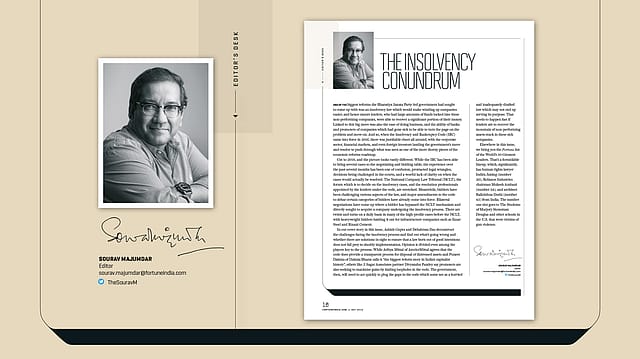
One of the biggest reforms the Bharatiya Janata Party-led government had sought to come up with was an insolvency law which would make winding up companies easier, and hence ensure lenders, who had large amounts of funds locked into these non-performing companies, were able to recover a significant portion of their money. Linked to this big move was also the ease of doing business, and the ability of banks and promoters of companies which had gone sick to be able to turn the page on the problem and move on. And so, when the Insolvency and Bankruptcy Code (IBC) came into force in 2016, there was justifiable cheer all around, with the corporate sector, financial markets, and even foreign investors lauding the government’s move and resolve to push through what was seen as one of the more thorny pieces of the economic reforms roadmap.
Cut to 2018, and the picture looks vastly different. While the IBC has been able to bring several cases to the negotiating and bidding table, the experience over the past several months has been one of confusion, protracted legal wrangles, decisions being challenged in the courts, and a woeful lack of clarity on when the cases would actually be resolved. The National Company Law Tribunal (NCLT), the forum which is to decide on the insolvency cases, and the resolution professionals appointed by the lenders under the code, are stretched. Meanwhile, bidders have been challenging various aspects of the law, and major amendments to the code to debar certain categories of bidders have already come into force. Bilateral negotiations have come up where a bidder has bypassed the NCLT mechanism and directly sought to acquire a company undergoing the insolvency process. There are twists and turns on a daily basis in many of the high-profile cases before the NCLT, with heavyweight bidders battling it out for infrastructure companies such as Essar Steel and Binani Cement.
In our cover story in this issue, Ashish Gupta and Debabrata Das deconstruct the challenges facing the insolvency process and find out what’s going wrong and whether there are solutions in sight to ensure that a law born out of good intentions does not fall prey to shoddy implementation. Opinion is divided even among the players key to the process. While Aditya Mittal of ArcelorMittal agrees that the code does provide a transparent process for disposal of distressed assets and Puneet Dalmia of Dalmia Bharat calls it “the biggest reform story in India’s capitalist history”, others like J. Sagar Associates partner Divyanshu Pandey say promoters are also seeking to maximise gains by finding loopholes in the code. The government, then, will need to act quickly to plug the gaps in the code which some see as a hurried and inadequately-drafted law which may not end up serving its purpose. That needs to happen fast if lenders are to recover the mountain of non-performing assets stuck in these sick companies.
January 2026
Netflix, which has been in India for a decade, has successfully struck a balance between high-class premium content and pricing that attracts a range of customers. Find out how the U.S. streaming giant evolved in India, plus an exclusive interview with CEO Ted Sarandos. Also read about the Best Investments for 2026, and how rising growth and easing inflation will come in handy for finance minister Nirmala Sitharaman as she prepares Budget 2026.
Elsewhere in this issue, we bring you the Fortune list of the World’s 50 Greatest Leaders. That’s a formidable lineup, which, significantly, has human rights lawyer Indira Jaising (number 20), Reliance Industries chairman Mukesh Ambani (number 24), and architect Balkrishna Doshi (number 43) from India. The number one slot goes to The Students of Marjory Stoneman Douglas and other schools in the U.S. that were victims of gun violence.
(The Fortune India May 2018 issue is on stands. Subscribe here)
